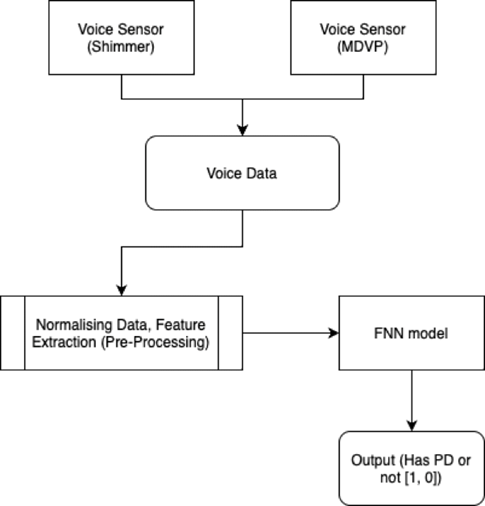Early Detection of Parkinson Disease using Voice Data
Main Article Content
Abstract
Parkinson’s disease affects over 10 million people worldwide, with approximately 20 percent of patients not being diagnosed. Clinical diagnosis is expensive because there are no specific tests or bio-markers, and it can take days to diagnose because it is based on a comprehensive evaluation of the individual’s symptoms. Existing research either predicts a Unified Parkinson Disease Rating Scale rating, uses other key Parkinsonian features to diagnose an individual, such as tapping, gait, and tremor, or focuses on different audio features. In this paper, we are focusing on using the voice aspect for the early detection of the disease. We use the University of California Irvine (UCI) Parkinson data set. This data set contains various parameters regarding voice jitter. The data set first undergoes preprocessing. We have used a Feedforward Neural Network (FNN) model to acquire early on detection using the above data set. Our model has achieved an efficiency of 97.43 percent. This efficiency can be improved by using even a larger and diverse data set.
Article Details
References
Bao G, Lin M, Sang X, Hou Y, Liu Y, Wu Y. Classification of Dysphonic Voices in Parkinson’s Disease with Semi-Supervised Competitive Learning Algorithm. Biosensors. 2022 Jul 9
Chaganti, Sai Yeshwanth, et al. ”Image Classification using SVM and CNN.” 2020 International Conference on Computer Science, Engineering and Applications (ICCSEA). IEEE, 2020.
Kotsiantis, Sotiris B., Ioannis D. Zaharakis, and Panayiotis E. Pintelas. ”Machine learning: a review of classification and combining techniques.” Artificial Intelligence Review 26.3 (2006): 159-190.
Kumari, LV Rajani, et al. ”Detection of Parkinson’s Disease using Extreme Gradient Boosting.” 2021 5th International Conference on Trends in Electronics and Informatics (ICOEI). IEEE, 2021.
Sakar, Betul Erdogdu, et al. ”Collection and analysis of a Parkinson speech dataset with multiple types of sound recordings.” IEEE Journal of Biomedical and Health Informatics 17.4 (2013): 828-834.
Muhammad Yusuf R. Siahaan, Rakhmad Arief Siregar, Faisal Amri Tanjung. (2023). Optimized Flexural Strength of Aluminium Honeycomb Sandwiches Using Fuzzy Logic Method for Load Bearing Application. International Journal of Intelligent Systems and Applications in Engineering, 11(4s), 466–472. Retrieved from https://ijisae.org/index.php/IJISAE/article/view/2704.
Lahmiri, Salim, and Amir Shmuel. ”Detection of Parkinson’s disease based on voice patterns ranking and optimized support vector machine.” Biomedical Signal Processing and Control 49 (2019): 427-433.
Panda,Archana,andPrachetBhuyan.”MachineLearning-BasedFrameworkforEarly Detection of Distinguishing Different Stages of Parkinson’s Disease.” Specialusis Ugdymas 2.43 (2022): 30-42.
Mr. Dharmesh Dhabliya, Dr.S.A.Sivakumar. (2019). Analysis and Design of Universal Shift Register Using Pulsed Latches . International Journal of New Practices in Management and Engineering, 8(03), 10 - 16. https://doi.org/10.17762/ijnpme.v8i03.78.
A. J. Lim and Y. H. Lee, ”A Review of the Assessment Methods of Voice Disorders in the Context of Parkinson’s Disease,” in Proceedings of the 12th International Conference on Biomedical Engineering, 2019, pp. 602-608.

